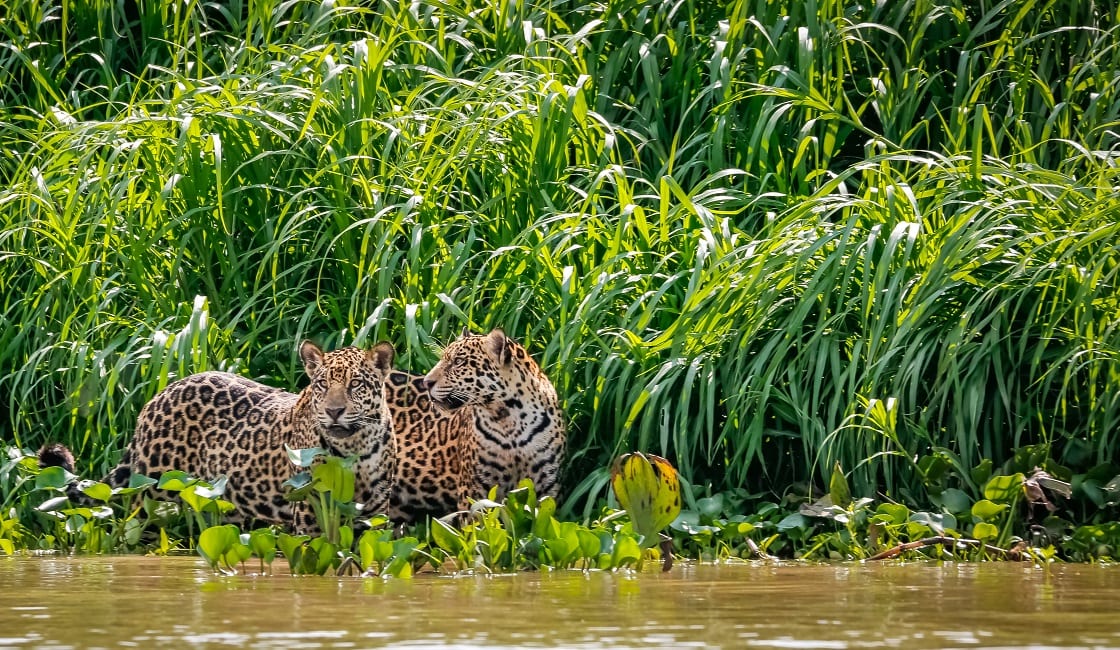
The Pantanal in Brazil is renowned for its spectacular wildlife sightings. A mecca for both birders and herpetologists alike, the world’s largest wetland is perhaps only more popular with those adventure travelers seeking the rare chance to catch a glimpse of the rare Jaguar.
The Pantanal is a vast network of wetlands, divided up by various waterways, such as the Claro, Cuiaba, and Piquiri rivers. It covers around 72,500 square miles and extends into two Brazilian states: Mato Grosso do Sul and Mato Grosso. Since 2000, the region has been a UNESCO World Heritage site and it is not hard to see why UNESCO was so impressed with the Pantanal.
The standout feature of the region is its astonishing biodiversity both on land and in the water. According to estimates, the Pantanal is home to over 650 species of bird, 325 fish species, 159 different species of mammal, and almost 100 reptile species. That’s not to mention all the insects and plants it boasts as well. While there are thousands of life forms to marvel at in the Pantanal, there is one that takes the limelight and is often the focus of Pantanal tours. That animal is the mighty jaguar.
With approximately 2,000 jaguars habituated in the Pantanal’s so-called “jaguar corridor” – the highest density of jaguars anywhere on the planet – sightings are more common here than in any other jaguar habitat in the world and this is a major selling point for the region. A jaguar sighting is far from guaranteed but there are things you can do to maximize the possibility.

Jaguar Hunting Capybaras On The Riverbank Pantanal
The first thing to do if your heart is set on seeing a jaguar in the Pantanal is to make sure you travel at the right time of year. The best time of year to see jaguars in the Pantanal is in the region’s dry season, between June and October. This is when jaguars often come out and bask in the sunlight on the banks of the various rivers that snake through the region. Or, if they aren’t relaxing, they are keenly stalking their favorite prey: caiman and capybaras.
Another important factor to consider on your quest to see a jaguar is where in the Pantanal you are going to travel. Despite being renowned as having the highest density of jaguars on the planet, in fact only about 63% (around 88,200 km2) of the Pantanal biome is actually occupied by jaguars. Historically, the northern Pantanal in the state of Mato Grosso has always had better odds for jaguar sightings (some spots of “Jaguarland” even claim a 75% chance of seeing a jaguar on any given day in the dry season) so you may want to consider directing your travels towards the north, although even the southern Pantanal has an estimated jaguar density of 6.5-7.0 jaguars/km2!
Furthermore, a Pantanal cruise on the region’s rivers is an optimal way to spot jaguars as the easiest place to find them is on the river banks. Going by foot takes you a little too close for comfort but traveling along the water allows you to see the animals from a safe distance without disturbing them.
One reason jaguars are easier to spot in the Pantanal compared to other parts of the world (apart from the visibility aspect of the region’s vast low-lying plains) is the abundance of prey. With millions of caiman and giant grazing capybara, the region is almost an all-you-can-eat buffet for such a formidable predator. Another is their history of interaction with humans. Whereas in the Amazon and other jungles jaguars have feared and stayed away from humans, in the Pantanal the creatures have become accustomed to their presence.
Fishermen that float up and down the rivers pay little attention to the jaguars on the banks, which in turn makes the jaguars feel comfortable enough to carry on their activities without paying any attention to the humans. Thankfully from a jaguar-spotting perspective, this familiarity means they tend not to run away when they hear boats coming or see boats with wildlife enthusiasts just a few meters away!
Planning your journey carefully is essential if you want to make the most out of a vacation to the Pantanal. You will need to pay particular attention to how you will get there and where you will stay. Unlike much of the rest of South America, in the Pantanal, it is almost impossible to be spontaneous. However, if you get everything sorted beforehand, you can maximize your chances of seeing a jaguar in the flesh.
While Rainforest Cruises aim to provide accurate and up-to-date information, we make no representations as to the accuracy or completeness of any information herein or found by following any link on this site. Rainforest Cruises cannot and will not accept responsibility for any omissions or inaccuracies, or for any consequences arising therefrom, including any losses, injuries, or damages resulting from the display or use of this information.




